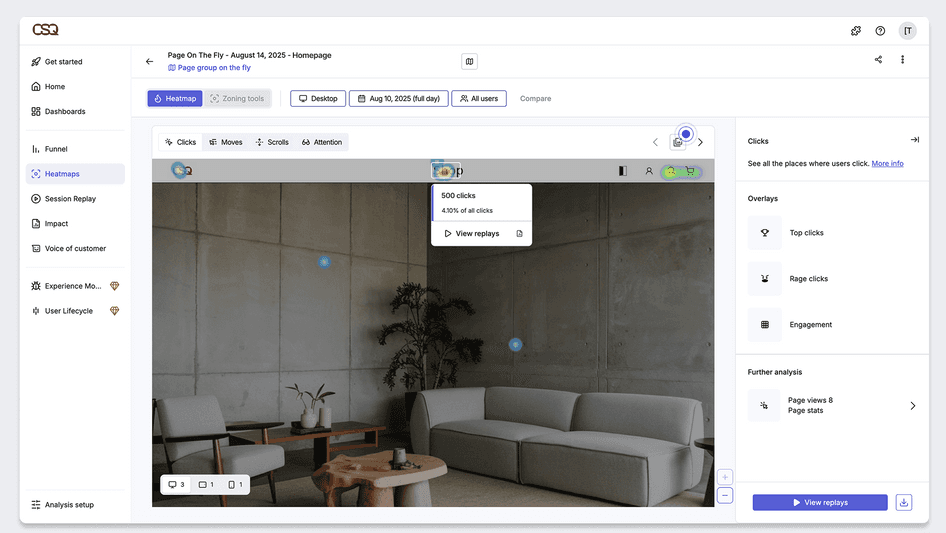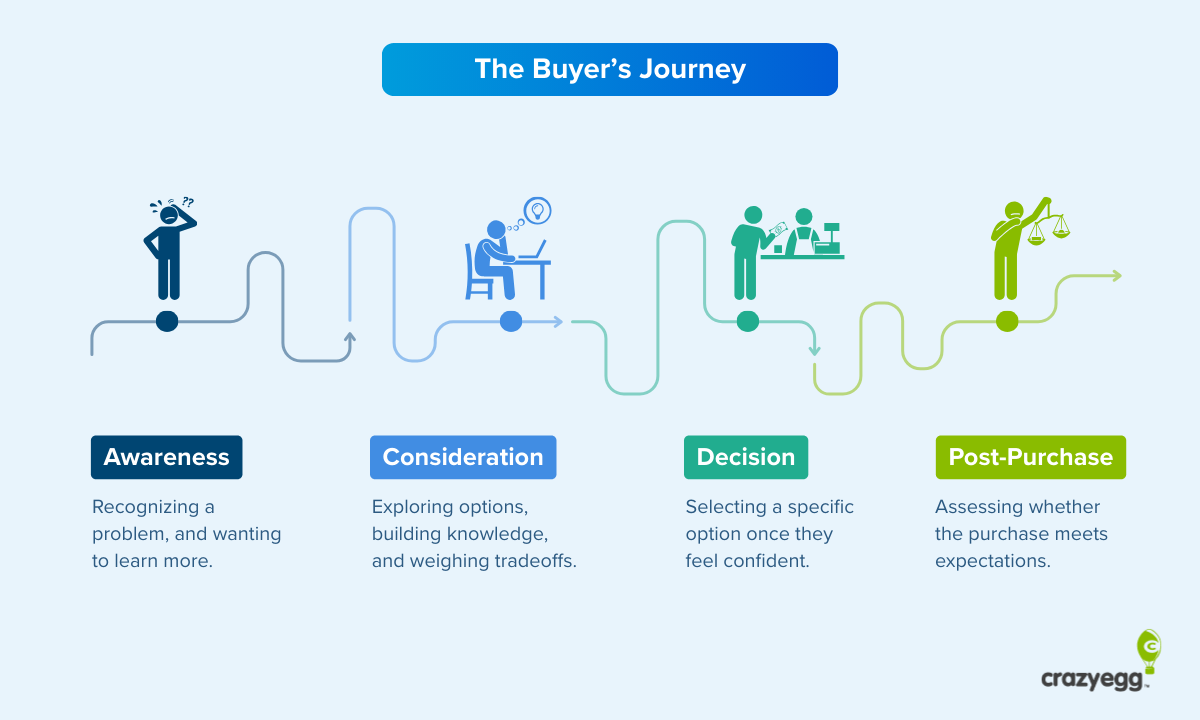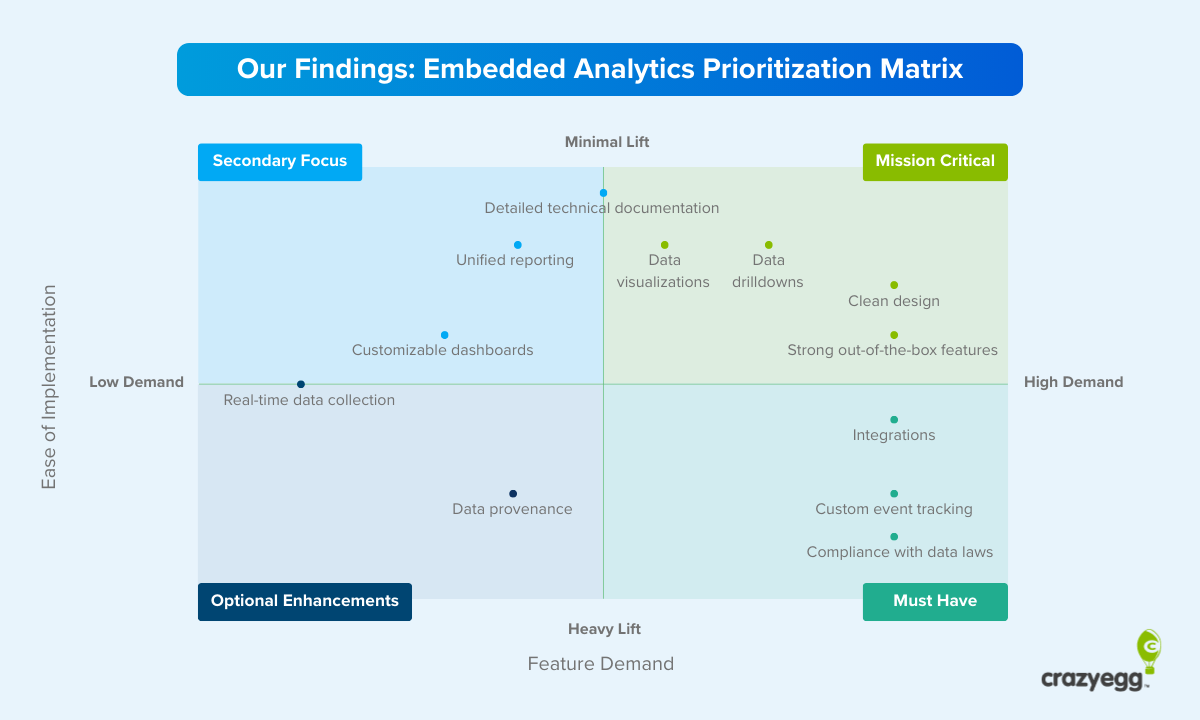A micro conversion is a small step a user takes on the journey toward making a bigger decision, like signing up, subscribing, or making a purchase.
A classic example? Adding a product to an online shopping cart.
You haven’t bought the product yet, but you’re closer to that big conversion than when you landed on the storefront.
These low-effort actions build momentum and ease the shift from inaction to commitment, one small yes at a time.
Today, we’ll study some of the best examples of micro conversions, plus where to use them for maximum impact.
4 Examples of Micro Conversions + Best Places to Put Them
1. Interactive Pop-Up Prompt
Example: As a user is browsing, a website presents a pop-up asking, “Do you want to improve your productivity?” with “Yes” and “No” options.
Choosing “Yes” leads to an email signup form.
Keep in mind that from the user’s end, pop-up prompts can be annoying if there’s no “Maybe Later” option. Personally, I feel a spike of frustration if I can’t quickly click out of the micro-conversion form.
Plus, when a company offers a third opt-out style button, I’m more likely to click “yes.” Why? Because I feel less like a captive audience and more like a potential customer whose agency is respected.
If you’d rather not hold users captive, try a micro-conversion like the one I found on Mott & Bow’s website. After browsing the site for about a minute, this little pop-up appeared in the bottom left corner.

This micro conversion pop-up doesn’t ask you to enter an email for 20% off. It doesn’t even ask a yes-or-no question.
The copy is extremely short and simple: “Want 20% off?” If this looks appealing, you can click the arrow. If it doesn’t, you can ignore it.
Easy peasy.
If you’re already on the website looking for a fresh pair of jeans, you’re almost certainly going to click the arrow.
I mean, who doesn’t want 20% off?
Why a pop-up works:
- Low commitment: The initial yes/no/maybe question asks readers to put in minimal effort. Using something even simpler, like Mott & Bow’s arrow, is even lower-effort. This reduces friction, making it easier for users to get one click closer to trading their email address for a 20% off coupon.
- Psychological momentum: Agreeing to the first prompt increases the likelihood that your web visitor will complete the next action. Like giving their email and phone number in exchange for a discount.
- Targeted engagement: Only the interested users click, which means better leads for you.
Where to put a pop-up:
- Bottom corner: If you don’t want to interrupt the user’s browsing experience, bottom-corner placement is the way to go. They’ll still see the button, but they can ignore or engage if they want to.
- Center of screen: Use these with exit-intent triggers so that they pop up only when users are about to leave a page. You don’t have anything to lose, so grab their attention with a front-and-center pop-up. Tip: play around with A/B testing to optimize your page for the best results.
2. Email Funnels That Start with a Soft Ask
Example: Instead of opening with a hard pitch, your email newsletter simply asks: “What’s your biggest challenge with [topic] right now?”
You can frame the question around a core pain point your audience cares about, but make sure it’s short. The goal is to invite a quick and easy response—not to write a whole book in your email.
If you sell polling software that allows people to split-test products in front of their target audience, you could make an email like this:
———————————————
Subject: Quick question about your next launch
Hi [First Name],
If you could test one thing with real buyers before launching your product, what would it be?
Packaging? Pricing? Product name?
Just hit reply and let me know. I’m curious to hear what’s on your radar right now.
— [Your Name] [Your Company]
———————————————
That’s it.
No signups, no mention of your product. Just a quick question that invites the reader to reply.
And when you do get those replies, use them as an opportunity to build a connection with your reader.
But whatever you do, don’t pitch-slap in your reply to their reply.
Here’s what to do instead:
- Acknowledge their answer with a genuine, thoughtful reply. Think of a time when you went through something similar and open up to the reader about it.
- Offer value, like a resource, a tip, or an example relevant to what they shared. You can loop in client success stories if they fit, but avoid sounding salesy. The goal here is for you to offer a small bit of help, free of charge (or strings).
- Then (if it feels natural), connect it to how your product helps. Pay attention to the if it feels natural part! If it doesn’t feel natural in the first few replies, no sweat. Be patient. Wait for a truly good and natural time and then open the door to further exploration of your product. But of course, if the person asks you directly about how your product works, jump right in!
The team at Mighty & Bright, an ecommerce store that sells magnetic calendars for families, does this well. Oftentimes, the header will include a quick question, like the one below: “Did you do this?”

Naturally, the reader wants to know what “this” is. Turns out, it’s a list of tips to get your home ready for winter. Instead of stopping at the question, the Mighty & Bright team lists out 10 to-dos to check off before winter hits.

These to-do lists are helpful and valuable for readers. Combined with the email’s super-friendly tone and the subject line question, they invite a response. All without being pushy about product sales.
Why a soft ask works:
When someone gets a simple question to answer early in an email funnel, it feels personal and low-pressure. They don’t have to commit to anything.
Instead, they just get to share a little about themselves.
And that tiny reply? That’s your micro conversion.
Now you know what your reader cares about, and you’ve begun a connection that can turn into a real, trusting relationship.
Use the information you gain to help guide your next email—or even inform a next step in your product development. Especially if the reader wants or needs something you don’t yet have.
Where to use a soft ask:
- Intro email: What better way to learn more about your newest subscribers than to ask them about their pain points?
- Re-engagement campaigns: If a subscriber hasn’t clicked in a while, ask a simple, open-ended question like, “Still working on [topic]?” or “What’s something we could help with in your work/life right now?”
- Lead magnet delivery emails: When someone downloads a freebie, you’ve got a perfect opportunity to ask them how they hope the resource will work for them. Ask, “What’s one thing you’re hoping this helps you solve?” Let the conversation flow from there.
3. Interactive Quizzes
Example: You land on the homepage for a skincare brand. A banner pops up, inviting you to “Quiz: Discover your ideal skincare routine!”
Curious, you click it and the promised quiz pops up. It looks something like this:
What’s your skin type?
- Oily
- Dry
- Combination
- Sensitive
What’s your top skin concern?
- Acne
- Redness
- Aging
- Dark spots
How many steps do you prefer in your routine?
- 1-2 steps (keep it simple)
- 3-4 steps (keep it balanced)
- 5+ steps (give me the full routine!)
Do you prefer fragrance-free products?
- Yes
- No
- Doesn’t matter
You click away, and in less than a minute, you get an ideal skincare routine breakdown with product recommendations. The skincare brand gets details about your preferences and an opportunity to connect you with products that fit.
That’s a beautiful micro conversion.
I like the real-life skincare quiz on INKEY’s website. It’s presented as a build-your-own skincare routine quiz and shows you exactly how much time it’ll take and what you’ll get upon completion.

I’m not particularly interested in skincare, but I was tempted to take the quiz anyway.
Another example is Universal Yums, a company that curates snack boxes from around the world. About a third of the way down the the Universal Yums homepage is an invitation to take a quiz.
The draw? After you take it, you’ll apparently find the perfect international snack box to fit your tastes.

Reader, I took the quiz.
To get the results, I had to enter my email address. Which is fine because I got a 10% coupon for my first box of Universal Yums.
I do wish the quiz results had been more exciting, though. In the end, the quiz gave me a recommendation for Universal Yums’ medium-sized box. Plus the option to pick from three different subscription types and decide which country box I’d get first.
Basically, a version of the Universal Yums pricing page.
I was expecting a specific set of countries or snack styles instead.
I mean, I gave the company all that information during the quiz, after all!

For me, this quiz fell flat. But yours doesn’t have to!
Make sure the user gets an actually valuable and personalized answer, and you’ll be good to go.
Why interactive quizzes work:
I don’t know about you, but I love answering quizzes. Remember when Buzzfeed constantly had quizzes you could answer to learn your ideal ice cream flavor or find out what type unicorn you’d be?
I love that stuff.
So do lots of other people.
Sort of.
There’s a general consensus on forums like Reddit that Buzzfeed quizzes are fun to take but pointless and a waste of time, too.
I mean, do you really need to know what type of bread you are?

Interactive funnel quizzes, on the other hand, offer something useful in return for the information given in a quiz.
This helps build trust between you and your newest leads.
Behind the scenes, every answer they give helps you find out more about your new leads and determine how your product can help them.
This will help you create customized offers and marketing campaigns later on.
Where to use an interactive quiz:
- Homepage banner or hero section: Capture attention right away by asking users if they want to take a fun little quiz to help find the right product or plan. As of this writing, an invitation to take the INKEY skincare routine quiz appears as promo banner on the site’s homepage.
- Exit-intent pop-up: Offer a quiz as a last-chance engagement tool before a user leaves the site.
- Lead magnet delivery page: After someone downloads a freebie, invite them to take a quiz to help personalize their next steps. Micro conversions aren’t just for winning leads! You can also use them to learn more about the people you’ve attracted to your site and converted to leads. Next step? Turn ’em into customers.
4. Sales Outreach That Starts with an Easy Question
Example: Instead of leading a cold LinkedIn message or sales email with “Would you like to book a demo?” your outreach email asks something easier.
Something less direct, like: “Have you ever run into issues with [common pain point]?” or “Is your [specific workflow process] something you’re looking to improve, or does it work pretty well right now?”
These are easy questions for new connections to answer, and they don’t sound overly salesy.
The goal here is to lead with curiosity and see what comes of the message thread.
Here’s how you could frame a curiosity-forward question in an actual message:
———————————————
Hi [First Name],
Saw you’re leading ops at [Company Name]. It’s always impressive keeping things running smoothly across teams and projects.
Quick question for you: How are you currently [managing/tracking/handling X] across different departments or workflows?
We built [Your SaaS Product] to help teams [solve common pain point]. Especially when things start to get messy across tools or teams.
Not a pitch—just genuinely curious how you’re handling it now.
Cheers, [Your Name]
———————————————
Whatever you do, make sure you respond thoughtfully to any reply they give.
Do not reply with a pitch.
I repeat: do not reply with a pitch.
Continue to let the curiosity lead you in the right direction. If they ask about you or your product, spill the deets!
If they don’t seem interested right now, don’t force it. Let the conversation go where it will and tuck the connection away for later. Mark them for a casual follow-up in a few months.
Who knows? Maybe by then they’ll be in a place where they do need your product, after all.
Or maybe not.
At worst, you’ve got a new connection. (A good thing!)
At best, you’ll get to move past the micro conversion, book a demo, and land a new client.
Why sales outreach framed around an easy question works:
These types of micro conversion messages work because they ask specific, low-friction questions. There’s no form to fill out, no meeting to book, just a question that speaks to the person’s pain point, a core tenant of great copywriting.
It also gives them context about your product without selling it directly. If the person is interested, they’ll let you know further along in the conversation. If they aren’t, that’s okay too.
Tip: always begin these cold outreach messages with a genuine and relevant compliment. Do your research!
Where to use a sales outreach message with an easy question:
- Cold emails or LinkedIn messages: Start the conversation without overwhelming your prospect with a pitch, demo, or meeting request.
- Follow-up after a conference or webinar: Re-engage your leads by referencing the event you both attended and asking a relevant yet low-friction question.
- Post-referral outreach: When someone’s introduced you, lead with curiosity instead of asking for a demo. This helps to start your relationship on a human, genuine level. The more you know about your referral’s specific areas of concern, the better you can demonstrate how your product will solve their problems.






